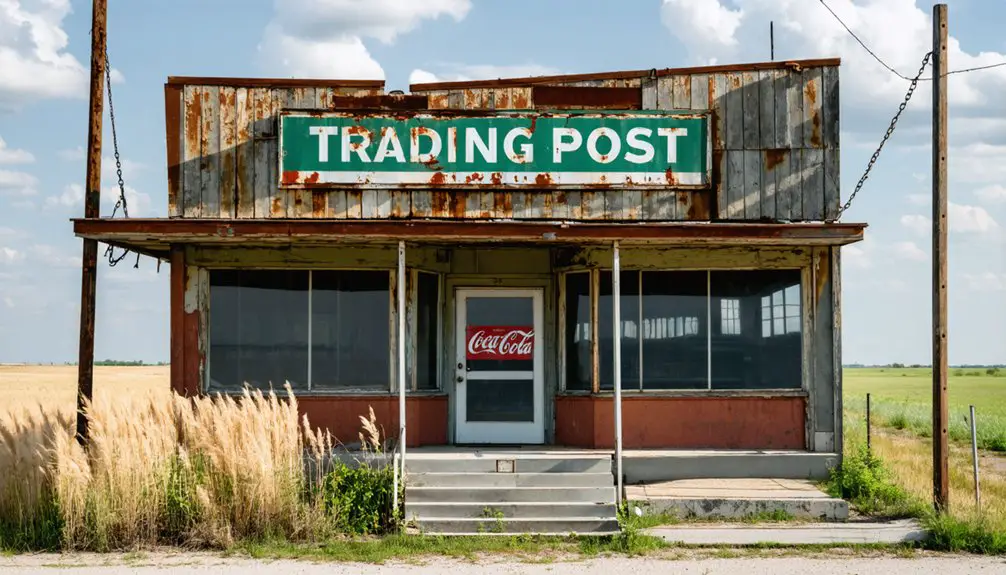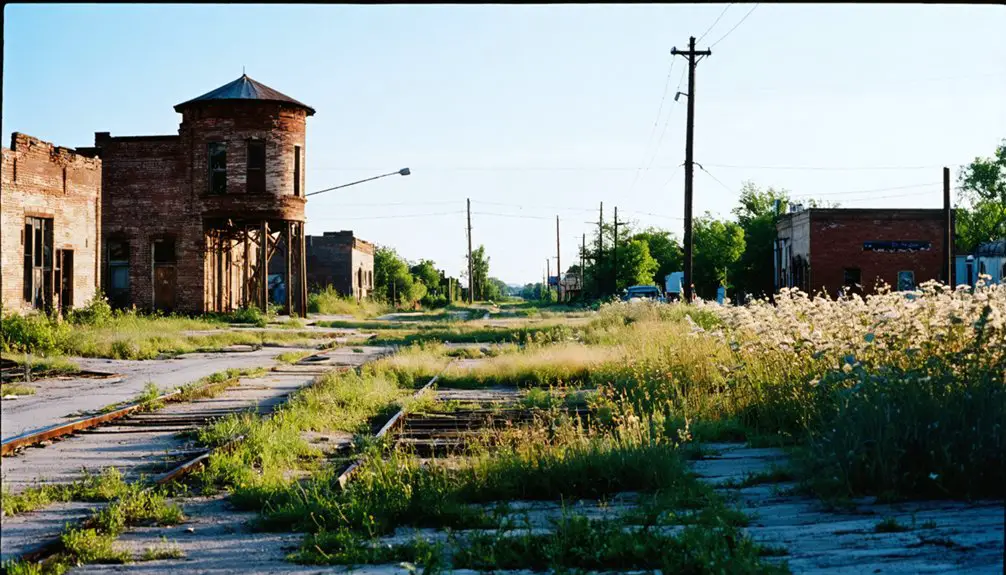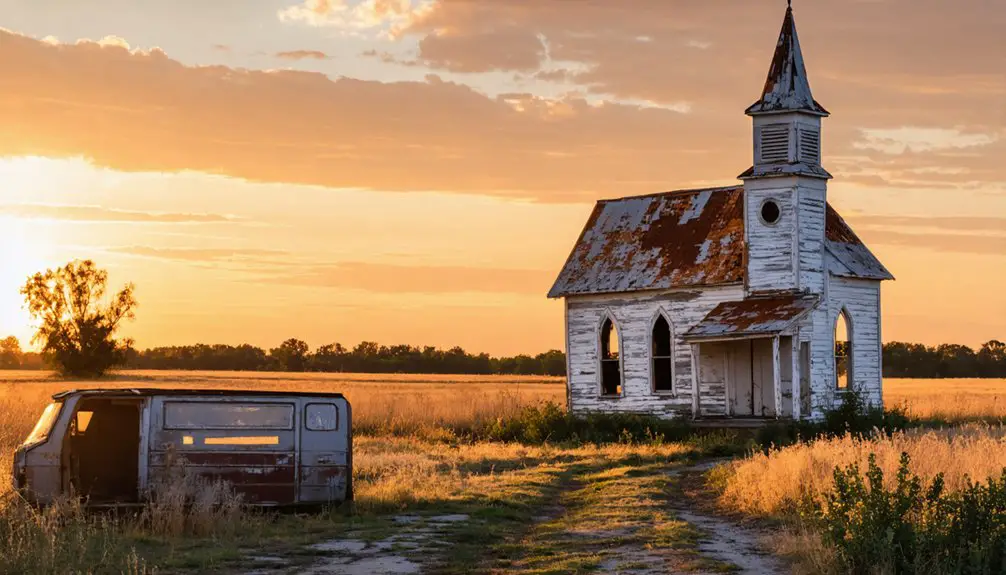You’ll find Navajoe’s remnants in southwestern Oklahoma, where this frontier town sprang up in 1886 along the Western Cattle Trail. W.H. Acers and H.P. Dale opened the first general store, and Buckskin Joe Works laid out an 80-acre townsite that quickly drew settlers. The town thrived as an essential trading post, with its Baptist church, schoolhouse, and store serving cowboys and Native American traders. But without railroad connections or rich resources, Navajoe’s bustling streets gradually emptied into ghostly silence – though its frontier spirit still whispers tales of the Old West.
Key Takeaways
- Navajoe began as a thriving trading post in 1886 near the Western Cattle Trail, established by W.H. Acers and H.P. Dale.
- The town served as a vital supply point for cattle drives, with its general store supporting both cowboys and Native American traders.
- Navajoe’s community centered around three main structures: the Baptist Church (1887), schoolhouse (1888), and general store.
- The town’s decline began when larger railroad-connected settlements emerged, coupled with a lack of valuable natural resources.
- The closure of Navajoe’s post office marked its transformation into a ghost town, leaving only empty buildings as remnants.
While most mountain ranges form through tectonic uplift, the Navajo Mountains emerged through a different process – the intrusion of molten igneous rock pushing upward through ancient sedimentary layers.
You’ll find the mountain’s core dates back over 1.8 billion years, with Precambrian metamorphic rocks serving as its foundation.
During the Paleozoic era, tropical seas deposited thick layers of limestone and shale, while the Mesozoic era brought vast sandstone formations from ancient rivers and windblown dunes. Much like the vast desert dunes of the Early Jurassic period, these formations covered extensive areas of the western United States.
The structural formation you’re looking at is called a laccolith – it’s created a massive dome rising 4,000 feet above the Rainbow Plateau. The landscape contains several diatremes and laccolith ranges characteristic of the Colorado Plateau region.
The landscape evolution continues today as winds sculpt the exposed sandstone layers, creating unique features across this geologically stable region.
Native American Conflicts and Raids
As tensions mounted in the mid-1800s, the Navajo Mountains became a focal point of fierce tribal warfare between the Navajo and Comanche peoples.
You’ll find that intertribal dynamics were shaped by daring horse raids and battles for territory control, with the Comanche-Kiowa alliance proving particularly formidable in these clashes.
The region’s violent history intensified in the 1870s when daily raids by Kiowa and Comanche warriors terrorized settler communities across Oklahoma and Texas. The discovery of gold near Apache lands in 1860 had already sparked increased tensions and violent raids in the region.
These resource struggles weren’t just about land – they represented a desperate fight for survival and sovereignty.
The Salt Creek Massacre of 1871 near Graham, Texas, stands as a stark reminder of the bloodshed, where Kiowa raiders killed seven men just a stone’s throw from what would become Navajoe. After the massacre, General Sherman dispatched Colonel MacKenzie to pursue the responsible Indian raiders.
Early Settlement and Town Founders
Deep in what was then Greer County, Texas, the story of Navajoe began in 1886 when brothers-in-law W.H. Acers and H.P. Dale built the first general store to trade with local Indians and cattle drovers.
The founders’ motivations were clear – they’d spotted a prime location near the Western Cattle Trail and Fort Sill Indian Reservation. Like the orderly and quiet communities of earlier frontier towns, they aimed to establish a respectable trading post.
You wouldn’t have recognized the bustling frontier town that emerged. Texas promoter “Buckskin Joe” Works swooped in by 1887, laying out an 80-acre townsite.
The town demographics exploded as he marketed half the lots to enthusiastic settlers. Within months, you’d have found the region’s first Protestant church, a post office, and a thriving trade center. The post office officially opened on September 1, 1887, distinguishing itself from its Arizona namesake.
The First Protestant Church in Indian Territory
Nearly two decades before Navajoe’s first church opened its doors, Union Mission made history as Indian Territory‘s first Protestant outpost.
Union Mission pioneered Protestant faith in Indian Territory, blazing a trail for future churches in the untamed frontier.
You’ll find its remnants in today’s Mayes County, where in 1820, Reverend Epaphras Chapman and his fellow missionaries picked a prime spot near the Neosho River. They weren’t just building a church – they were launching Protestant missions across the frontier with backing from Presbyterian, Dutch Reformed, and Associated Reformed churches back East.
The mission folks set up log houses and opened Oklahoma’s first schoolhouse in 1821. Following the First Great Awakening, missionaries intensified their evangelism efforts among Native Americans. By 1826, the United Foreign Missionary Society merged with the American Board of Commissioners for Foreign Missions.
While they aimed for cultural assimilation of Native Americans into European ways, some tribes used their new Christian education to protect their political rights and land.
Despite facing resistance and war-time disruptions, Union Mission laid the groundwork for faith and learning in Indian Territory.
Life Along the Western Cattle Trail
You’ll find that cowboys driving cattle north on the Western Trail near Navajoe relied heavily on local traders and supply points to restock their chuck wagons with essentials like flour, beans, and coffee.
Along this stretch of trail, cowboys’d pause their massive 3,000-head herds to trade with local merchants, rest their horses, and replenish water supplies at reliable spots like Wolf Creek. This vital route helped move an estimated six million cattle along the trail system during its peak operating years. The trail reached its highest volume in 1881, when 301,000 cattle were driven north.
These brief stops brought welcome commerce to tiny settlements, where trail bosses might spend $150-200 on provisions while their crews enjoyed a brief respite from the grueling months-long journey.
Trail Supply Operations
Along the Western Cattle Trail, strategic supply points like Doan’s Crossing served as essential lifelines for cattle drives entering Indian Territory.
You’d find these outposts bustling with up to 300 folks, offering everything from hotels and saloons to supply houses and branding pens.
Trail logistics demanded careful planning around water sources and terrain, with routes broadening near spots like Elk Creek for grazing.
At these supply points, you’d stock up on Stetson hats, guns, ammunition, and provisions needed for the long drive ahead.
The supply routes connected naturally with the trail’s geography, avoiding rough spots like the Gypsum Hills.
Wagon yards and corrals dotted these stops, where you could tend to your gear, brand cattle, and rest up before tackling the next stretch of trail.
Cowboys Meet Local Traders
Life on the Western Cattle Trail brought cowboys face-to-face with Plains Indian tribes and local traders, creating a rich tapestry of cultural exchange. You’d find these cowboys interactions happening at places like Doan’s Crossing, where drovers stocked up on essential supplies before heading into Indian Territory.
Trading posts weren’t just about business – they became social hubs where you’d share news and stories while replenishing your tobacco and ammunition.
Local trader diplomacy played a vital role, especially when negotiating passage rights with Cheyenne, Arapaho, and other Plains tribes. Sometimes you’d need military escorts through trickier territories, but most exchanges were peaceful.
Native Americans often traded for fresh beef to supplement their rations, while sharing invaluable knowledge about the terrain and weather patterns ahead on your journey.
Daily Life and Commerce
When the Western Cattle Trail reached its peak, nearly every aspect of daily commerce revolved around the constant flow of cattle and cowboys passing through settlements like Navajoe.
You’d find trail hands managing herds of thousands, each cowboy rotating through seven horses while pushing cattle northward. Local merchants made their living supplying these rough riders with everything from hats and guns to tobacco and provisions.
Cattle management meant good business for townsfolk who provided essential services like blacksmithing, wagon repairs, and veterinary care.
The community growth was unmistakable – hotels, saloons, and supply stores popped up to serve the endless stream of trail crews. At $20 to $35 per head, the cattle trade brought serious money through town, though the cowboys themselves lived sparse lives until reaching their destination up north.
Trading Post and Commerce

You’ll find that Navajoe served as a vital supply hub for traders moving along the Western Cattle Trail during the late 1800s.
The trading post stocked essential provisions like ammunition, dried goods, and basic supplies that both cowboys and travelers needed for their journeys.
Local merchants set up shop to capitalize on the steady stream of cattle drives passing through, making Navajoe a brief but important stop for commerce along the trail.
Supply Hub For Traders
The frontier trading posts of Navajoe emerged as essential supply hubs after 1868, when Navajo people returned from their exile at Bosque Redondo.
You’d find these posts strategically placed near water sources and roads, making trader interactions easier for both natives and merchants. As railroads pushed through in 1882, supply strategies evolved from basic tent setups to permanent structures stocked with life’s necessities.
If you’d walked into one of these posts, you’d have found shelves lined with coffee, flour, sugar, and canned goods.
Behind the counter, traders kept valuable items like cookware, saddles, and hardware. The savvy traders knew to stock exactly what their customers needed – from calico cloth to baking powder.
These weren’t just stores; they were lifelines connecting the Navajo to essential goods and commerce.
Western Cattle Trail Commerce
Standing proudly at Doan’s Crossing along the Prairie Dog Town Fork of the Red River, Corwin Doan’s trading post marked a major milestone for cattle drovers heading north through Indian Territory.
You’d find this essential outpost about 13 miles northeast of Vernon, Texas, where it served as the last reliable stop before the challenging drive north.
The trading post significance went beyond basic supplies – it became a hub where cattlemen struck deals with Comanche, Kiowa, and other tribes who’d trade for fresh beef to supplement their rations.
The cattle drive economics flourished here as drovers moved their herds toward northern feeders where they’d fatten up the livestock before sending them to market.
At roughly 8-10 miles per day, you couldn’t find a more welcome sight than Doan’s Crossing after weeks on the trail.
Territorial Transitions
During the late 1800s, dramatic changes swept across what you’d now recognize as Oklahoma, transforming it from Indian Territory into organized Oklahoma Territory.
On May 2, 1890, President Harrison’s Oklahoma Organic Act established territorial governance, carving out six counties from the Unassigned Lands and adding the lawless No Man’s Land as a seventh.
You’d have seen the old tribal system crumbling as land allotments forced Native Americans to accept individual parcels, with “surplus” lands opening to settlers at $1.25 per acre.
The Curtis Act of 1898 further dismantled tribal governments and communal ownership, paving the way for white settlement.
If you’d been there, you’d have witnessed the territory’s rapid transformation through land runs and population booms that set the stage for statehood in 1907.
Town Layout and Development

From humble beginnings near the Western Cattle Trail, Navajoe’s town layout emerged in 1886 when W.H. Acers and H.P. Dale established their general store.
You’ll find that town planning took a significant turn when Buckskin Joe Works arrived in 1887, surveying and dividing an 80-acre plot into a proper settlement. Works’ economic strategies centered on positioning the town advantageously at the base of the Navajo Mountains, near crucial trade routes.
The layout you’d have seen included carefully planned spaces for homes, businesses, churches, and schools.
The First Baptist Church and post office anchored the community’s early infrastructure, while the general store served as a bustling hub of commerce.
The town’s design maximized its connection to the Western Cattle Trail, supporting trade with both settlers and Native Americans from nearby Fort Sill.
The Legacy of Buckskin Joe Works
When Buckskin Joe Works rode into Navajoe on July 4, 1887, he’d already made his name as a savvy Texas land promoter. Through his Texas-Oklahoma Colony and *The Emigrant Guide*, he transformed a remote trading post into a bustling frontier town.
You can trace Buckskin Joe’s impact through his clever promotional strategies that brought over 200 families to settle there within just a few years.
His vision didn’t stop at population growth. He helped establish the town’s first Baptist church, brought in essential businesses, and created a foundation for law and order.
Buckskin Joe saw beyond mere numbers, building a complete community with faith, commerce, and justice at its core.
While Navajoe eventually faded when the railroad passed it by, Buckskin Joe’s legacy lives on as a reflection of the pioneering spirit that shaped Oklahoma Territory, proving that one determined individual could carve civilization from the wilderness.
From Frontier Town to Ghost Town
You’d find bustling trade at Navajoe’s general store in the late 1880s, where cattle drovers and local tribes exchanged goods while moving along the Western Trail.
By 1887, settlers had put down roots with a Baptist church and schoolhouse, creating a proper frontier community where kids learned their letters and folks gathered on Sundays.
The promising town couldn’t survive being bypassed by the railroad and the changing cattle routes, leaving only quiet ruins where a lively community once stood.
Early Trade and Commerce
As frontier towns sprouted across the Texas-Oklahoma border in the late 1880s, Navajoe emerged as a strategic trading post where W.H. Acers and H.P. Dale established their general store in 1886.
You’d have found them trading with local Indians and cattle herders pushing north to Kansas markets. When “Buckskin Joe” Works rode into town on July 4, 1887, he laid out 80 acres and received half the town lots for his promotion efforts.
The post office opened that September, deliberately spelled “Navajoe” to avoid confusion with Arizona’s Navajo. Trade routes through the Navajo Mountains brought both opportunity and risk, as conflicts with Comanche and Kiowa tribes persisted.
The town’s economic stability grew with the addition of the Baptist Church and Navajoe School, serving travelers and locals alike.
Settlers Build Community Life
Three distinct pillars anchored Navajoe’s early community life: the Baptist Church, established right after the town’s founding in 1887, the newly opened schoolhouse in 1888, and the bustling general store that served as the social hub.
You’d find settler interactions happening daily at these gathering spots, where folks traded not just goods but news and stories too.
The general store, started by Acers and Dale, became the place where cowhands, Native Americans, and settlers all crossed paths. Community traditions took root quickly, with Fourth of July picnics drawing folks from all around.
At the Baptist Church – the first Protestant church in Indian Territory – you’d see neighbors coming together to worship and build lasting bonds.
The schoolhouse showed these pioneers weren’t just passing through; they were putting down roots for keeps.
Abandonment and Empty Streets
Despite the early promise of community bonds and gathering spots, Navajoe’s bustling streets began emptying in the late 1800s.
You’d have seen the major abandonment factors unfold as larger towns with railroad connections drew folks away from this once-hopeful trading post. Without oil, minerals, or rich farmland to sustain it, the town couldn’t keep its residents rooted.
The ghost town characteristics emerged steadily – first the post office closed, then churches went quiet, and schools shuttered their doors.
If you’d walked these streets in the early 1900s, you’d have found the old general store standing empty, a silent reminder of busier days.
The town that once served Native American traders and cattle drovers along the Western Trail had surrendered to the harsh realities of frontier economics and changing times.
Frequently Asked Questions
You’ll find those abandoned structures were left to decay naturally after folks moved away, with no historical preservation efforts saving them. Most were dismantled for materials or simply rotted away.
You’ll find that Navajoe’s peak residents weren’t precisely documented, but given the town’s modest size and comparison to nearby settlements like Cestos and Texola, we’d reckon demographics topped out around 300-400 folks.
Despite tantalizing frontier possibilities, you won’t find any documented outlaw encounters or lawman legends here. No famous gunslingers or sheriffs are known to have visited during the town’s existence.
What Natural Disasters or Events Affected the Town’s Development?
You won’t find specific records of flood damage or drought impact hitting the town directly – historical sources don’t mention any major natural disasters affecting Navajoe’s development or decline.
Like scattered breadcrumbs of history, you’ll find no official grave markers today, though local lore suggests early settlers and Native Americans left unmarked burial sites in the surrounding Navajo Mountains area.
References
- https://kids.kiddle.co/Navajoe
- https://digging-history.com/2014/09/24/ghost-town-wednesday-navajoe-oklahoma/
- https://www.youtube.com/watch?v=-jYN1_E2VV0
- https://socorronm.org/wp-content/uploads/2013/06/Ghost-Towns-of-Socorro-County-Part-2.pdf
- https://www.okhistory.org/publications/enc/entry?entry=GH002
- https://serc.carleton.edu/research_education/nativelands/navajo/geology.html
- https://pubs.usgs.gov/bul/0865/report.pdf
- https://www.bia.gov/sites/default/files/dup/assets/public/pdf/idc2-060714.pdf
- https://www.geolsoc.org.uk/science-and-policy/plate-tectonic-stories/navajo-sandstone/
- https://npshistory.com/series/berkeley/navajo-geology.pdf



